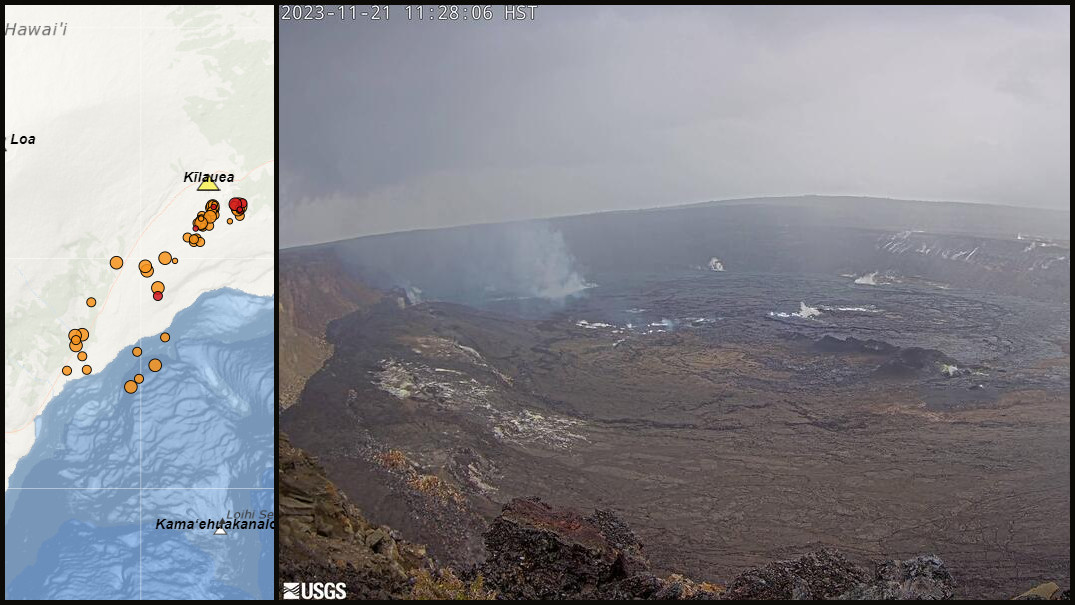This story appears in the above BIVN Update. The video will jump to the associated story when played. (A synthesized voice was utilized in the narration for this story)
(BIVN) – The latest episode of seismic activity at the summit of Kīlauea volcano increased on Tuesday morning, with a new cluster of earthquakes observed in the upper East Rift Zone.
Hawaiʻi Volcanoes National Park has closed Chain of Craters Road at the Devastation parking area as a precautionary measure due to the increased seismic activity.
The USGS Hawaiian Volcano Observatory interactive map tracked the activity, and this update was later provided by the scientists:
Activity Summary: Kīlauea volcano is not erupting. The unrest associated with the intrusion that began in early October southwest of Kīlauea’s summit increased this morning November 21. Seismic activity in the south part of Kīlauea’s caldera, which has been elevated over the last week, increased in the early morning hours and was followed by a cluster of earthquakes around 8 a.m. in the upper East Rift Zone. Unrest may continue to wax and wane with changes to the input of magma into the area and eruptive activity could occur in the near future with little or no warning. No unusual activity has been noted along the middle and lower sections of Kīlauea’s East Rift Zone.
Summit Observations: A new episode of earthquake activity began this morning Monday, November 21, in the south caldera, and upper East Rift Zones. Fourty-five earthquakes were observed in the southern part of the caldera including two magnitude 2.8 quakes in the past 24 hours along with twenty five earthquakes in the upper East Rift Zone. The new episode of earthquake activity in the upper East Rift Zone began around 8 a.m. this morning Tuesday November 21 between Puhimau and Hiiaka Craters. The largest earthquakes were magnitude 3.2 and 2.8 accompanied by many smaller earthquakes not located on maps.
The Uēkahuna summit tiltmeter, located northwest of the caldera had a modest increase in tilt in the past 24 hours. The Sand Hill tiltmeter, located southwest of the caldera, had moderate observable inflation in the last 24 hours. However, overall, the summit of Kīlauea remains at a high level of inflation, above the level reached prior to the most recent eruption in September 2023.
Sulfur dioxide (SO2) emission rates remain low. Field observations found SO2 gas emmision of 100 tonnes per day on November 17th. This is the same as an observation in October 2023.
There is currently no sign of an imminent eruption, but the increased seismicity around the summit and upper East Rift Zones are similar to events that have preceded other eruptions. The most likely location for renewed eruptive activity is within Kīlauea caldera, but it is also possible that an eruption could occur in the upper East Rift Zone. It is also possible that the seisimic activity observed today may subside and no eruption will occur. The onsets of previous summit eruptions have been marked by strong swarms of earthquakes caused by the emplacement of a dike 1-2 hours before eruptions and these have not been detected at this time.
Later in the update, the USGS HVO provided more detail on the Upper East Rift Zone activity:
This morning, a swarm of earthquakes, including four larger earthquakes, began on the upper East Rift Zone. The 4 largest earthquakes occured in the south caldera (M2.8), southwest of the caldera (M2.0) and upper East Rift Zone (M3.2 and M2.8).
We continue to closely monitor this area. There have been several minor episodes of seismicity in the Upper East Rift Zone in the past month, but no unusual activity has been noted along the rest of the East Rift Zone. Measurements from continuous gas monitoring stations downwind of Puʻuʻōʻō in the middle East Rift Zone have been below detection limits for SO2, indicating that SO2 emissions from Puʻuʻōʻō are negligible.


by Big Island Video News11:54 am
on at
STORY SUMMARY
HAWAIʻI VOLCANOES NATIONAL PARK - The unrest at the summit of Kīlauea increased on Tuesday morning, and a cluster of earthquakes shook the upper East Rift Zone at around 8 a.m.